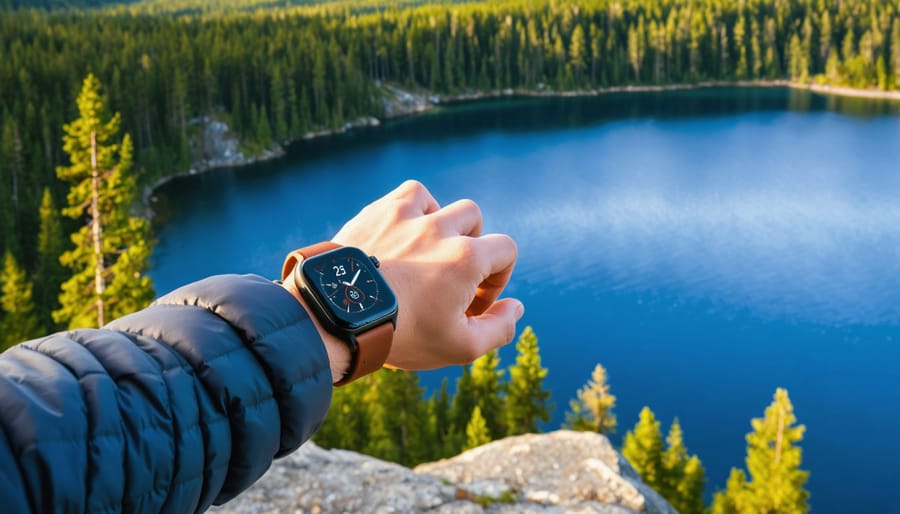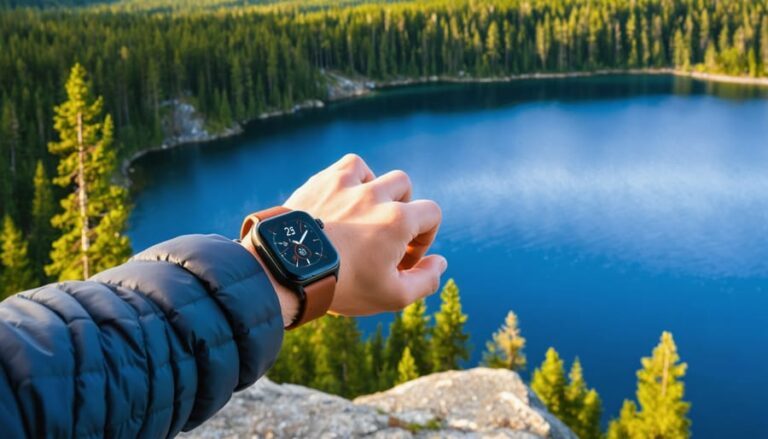Strap on a heart rate monitor before hitting the trails to catch early warning signs of overexertion—your device will alert you when you’re pushing too hard, especially crucial during summer hikes when heat stress sneaks up faster than you realize. Match your wearable to your activity: fitness watches with GPS tracking work brilliantly for long-distance hiking and cycling, while simpler step counters suit casual nature walks where you want minimal distractions from the scenery.
Check your resting heart rate each morning at camp; a sudden 10-beat increase often signals your body needs rest before tackling that challenging portage or steep climb. Most Ontario park visitors don’t realize their smartwatch can detect irregular heart rhythms during physical activity, potentially catching issues before they become emergencies miles from the nearest ranger station.
Download offline maps to your wearable before entering remote park areas where cell service disappears—devices like Garmin and Apple Watch let you navigate backcountry trails while simultaneously monitoring your oxygen saturation levels at higher elevations. Set custom activity zones based on your fitness level rather than generic settings; a moderate heart rate for experienced hikers differs vastly from weekend warriors exploring Ontario’s beautiful provincial parks.
Sync your device with weather apps that alert you to sudden temperature drops or storms, giving you time to seek shelter while your wearable continues tracking your core body temperature. The combination of real-time health data and environmental awareness transforms your park experience from guesswork into informed adventure, letting you explore farther and safer than ever before.
Why Your Next Park Visit Needs Wearable Health Tech
The Safety Net You Wear on Your Wrist
Picture this: you’re exploring a remote trail in Frontenac Provincial Park when your wearable detects an irregular heartbeat and sends an alert to your emergency contact. This isn’t science fiction – it’s happening right now across Ontario’s parks.
Modern wearables act as your personal safety guardian during outdoor adventures. They continuously monitor vital signs and can detect dangerous situations before they escalate. Last summer, a hiker’s smartwatch detected a sudden heart rate spike and automatically contacted emergency services, potentially saving his life. Similarly, fall detection has helped locate injured visitors who couldn’t call for help themselves.
Getting lost is another real concern, but GPS-enabled wearables now share your location with designated contacts. Combined with smart park technology, these devices create multiple safety layers.
Insider tip: before heading into remote areas, test your wearable’s emergency features and ensure your emergency contacts are properly set up. Also, consider eco-friendly solar-powered chargers to keep devices running during multi-day trips. Peace of mind shouldn’t drain natural resources or your battery.
Understanding Your Body’s Outdoor Performance
Your wearable device becomes your personal outdoor coach, helping you find that sweet spot between pushing your limits and knowing when to ease up. When you’re hiking Algonquin’s rugged trails or cycling along the Waterfront Trail, tracking metrics like heart rate and exertion levels helps you maintain a sustainable pace. I’ve learned this lesson the hard way—nothing cuts an adventure short faster than burning out too early!
Ontario’s diverse terrain means your body faces different challenges throughout the day. As you climb higher elevations, even modest increases affect oxygen availability and heart rate. Your wearable alerts you to these changes so you can adjust accordingly. Temperature fluctuations matter too, especially during spring and fall when morning chill gives way to afternoon warmth. Many devices now track your body’s temperature response, reminding you to add or shed layers before discomfort sets in.
Here’s an insider tip: hydration tracking is a game-changer. Some wearables estimate fluid loss based on activity intensity and weather conditions, prompting you to drink before you feel thirsty. This awareness means longer, more enjoyable outings without the dreaded mid-hike fatigue. By understanding what your body’s telling you through these metrics, you’ll pack in more adventures while staying safe and energized.
The Best Wearable Tech for Ontario Park Explorers

Smartwatches: Your All-in-One Trail Companion
Modern smartwatches have become indispensable companions for Ontario’s outdoor enthusiasts, packing professional-grade features into devices that sit comfortably on your wrist. When you’re exploring Frontenac’s backcountry trails, these digital helpers do far more than tell time.
GPS tracking stands out as perhaps the most crucial feature for park visitors. Your smartwatch maps your route in real-time, helping you navigate unfamiliar trails and retrace your steps if needed. I’ve found this particularly reassuring on those fog-shrouded morning hikes where familiar landmarks suddenly disappear. The heart rate monitor keeps you informed about your exertion levels, helping you pace yourself during challenging climbs and ensuring you’re not pushing too hard at high elevations.
Weather alerts deserve special mention for Ontario’s unpredictable conditions. Your watch can notify you of approaching storms, giving you precious time to seek shelter or adjust your plans. The emergency SOS function provides peace of mind, allowing you to signal for help even when your phone stays tucked away in your pack.
Here’s an insider tip for remote camping trips: battery life becomes your limiting factor. Enable airplane mode to conserve power, and consider bringing a portable solar charger rated for outdoor use. Most quality smartwatches last 18-30 hours with GPS active, so plan accordingly. Switch to battery-saver mode overnight, and you’ll extend that runtime significantly, ensuring your digital companion stays functional throughout your entire adventure.
Fitness Trackers for Casual Park-Goers
You don’t need fancy equipment to track your health while enjoying Ontario’s beautiful parks! Budget-friendly fitness trackers are perfect companions for families strolling through Springbank Park or couples walking the waterfront trails.
Simple bands from brands like Fitbit Inspire and Xiaomi Mi Band offer everything casual park-goers need. They count your steps (try hitting 10,000 while exploring a new trail!), monitor your heart rate during those slightly-steeper-than-expected hills, and track calories burned during afternoon picnics-turned-frisbee-sessions.
Here’s an insider tip: set hourly movement reminders. When you’re settled under a shade tree with a good book at Kilbear Provincial Park, these gentle buzzes encourage you to take short walks, keeping your circulation flowing and helping you discover hidden spots you might otherwise miss.
Many affordable trackers sync with smartphone apps that turn your park visits into friendly competitions. My family loves comparing our weekend step counts – it’s transformed our casual park outings into mini-adventures as we explore new paths.
Battery life matters too. Budget trackers typically last 5-7 days, meaning you won’t miss tracking those spontaneous Saturday hikes. Plus, most are water-resistant, handling surprise rain showers and enthusiastic creek-side exploring with ease.
Specialized Monitors for Serious Adventurers
For those venturing into Ontario’s backcountry trails or planning high-altitude hikes, specialized monitoring devices offer precision that standard fitness trackers can’t match. Chest strap heart rate monitors, like those from Garmin and Polar, provide medical-grade accuracy that’s essential when you’re pushing limits on challenging terrain. I learned this firsthand during a grueling portage in Algonquin – my wrist-based tracker showed wildly different readings than my friend’s chest strap, which helped him pace himself perfectly.
Pulse oximeters have become invaluable for monitoring blood oxygen levels, particularly useful if you’re exploring higher elevations or have respiratory concerns. These compact devices clip onto your finger and provide instant feedback about how your body’s adapting to altitude changes.
GPS-specific devices designed for backcountry exploration combine health monitoring with navigation features, ensuring you stay both safe and found. Many models now offer satellite communication capabilities – a genuine lifesaver when you’re beyond cell coverage.
Here’s an insider tip: invest in rechargeable battery systems rather than disposable ones. Not only will you save money over time, but you’ll also reduce waste in our precious wilderness areas. Solar charging options work brilliantly for multi-day adventures, keeping your devices powered while minimizing environmental impact.
What Features Actually Matter in the Wilderness
When I first ventured into Algonquin’s backcountry with my shiny new smartwatch, I learned a hard lesson. Three days in, the battery died despite its “10-day promise,” and I realized I’d been too focused on fancy heart rate zones rather than basics. Here’s what truly matters out there.
Battery life trumps everything. Look for devices lasting at least five days with GPS active, longer if you’re planning extended trips. Trust me, solar charging features are worth the investment.
Water resistance isn’t negotiable in Ontario’s unpredictable weather. Aim for IP68 rating minimum – your device should survive a surprise rainstorm or an accidental dunk in a creek.
Durability means more than a pretty display. Gorilla Glass and reinforced casings protect against the inevitable bumps on rocky trails. I’ve watched lightweight runners crack screens on a single branch.
Offline functionality saves the day when you’re beyond cell service, which happens frequently in provincial parks. Your wearable should track and store data independently, syncing later when you return to civilization. Those connectivity-dependent features? They’re useless baggage in the wilderness. Focus on devices that work independently, keeping you safe and informed regardless of signal bars.
What Your Wearable Can Tell You on the Trail

Heart Rate: Your Body’s Warning System
Your heart rate tells a story during outdoor fitness activities, and understanding what it’s saying can keep you safe on the trail. Most wearables track five heart rate zones, from light activity (50-60% of your maximum) to peak effort (90-100%). During that steep climb up Booth’s Rock Trail in Algonquin, you might hit zone 4—that’s normal. But if you’re still in zone 4 after ten minutes of flat walking, it’s time for a water break.
Here’s a practical example: imagine portaging your canoe at Killarney Provincial Park. Your watch shows 165 beats per minute—higher than your usual zone 3. That’s your body warning you to rest before tackling the next section. Similarly, if your resting heart rate climbs 10 beats above normal on day three of a backcountry trip, you might be overtraining or fighting dehydration.
Insider tip: Check your heart rate recovery. After stopping at a scenic lookout, a healthy drop of 20 beats within the first minute signals good fitness. Anything less? Your body needs more recovery time between challenging hikes.
Steps, Distance, and Elevation Tracking
Modern wearables turn trail adventures into personalized fitness journeys. These devices count every step, calculate distance covered, and measure elevation gain—transforming a simple hike into quantifiable progress you can actually see.
Here’s where it gets practical: knowing a trail gains 300 meters of elevation over 8 kilometers helps you estimate completion time and energy requirements. If your typical pace covers 4 kilometers per hour on flat terrain, expect that hilly trail to take closer to three hours. Your wearable tracks this data in real-time, helping you decide whether to push forward or turn back before sunset.
Insider tip: Review your historical data after a few outings. Notice you consistently handle 500-step climbs without stopping? You’re ready for Ontario’s intermediate trails. Struggling after 200 meters of elevation? Stick with gentler paths until your fitness improves. This self-knowledge prevents overextension and builds confidence gradually. Plus, watching your step count climb toward daily goals adds satisfying motivation to explore just one more lookout point before heading home.
Sleep and Recovery Monitoring for Multi-Day Trips
Multi-day camping trips in Ontario’s parks demand a lot from your body, and sleep tracking becomes your secret weapon for pacing yourself properly. Modern wearables monitor sleep stages, heart rate variability, and restlessness throughout the night, giving you a recovery score each morning. When I’m backpacking Algonquin’s highland trails, I check my recovery metrics before deciding whether to tackle that ambitious 15-kilometer day or opt for a gentler paddle instead.
Sleeping outdoors presents unique challenges that affect these readings. Ground temperature, unfamiliar sounds, and that lumpy spot under your tent can disrupt deep sleep phases. Your wearable captures this data, helping you identify patterns. Maybe you sleep better after setting up camp earlier, or perhaps that extra insulation pad makes a measurable difference. One insider tip: if your device shows poor recovery despite feeling okay, trust the data and build in a rest day. Your body needs time to adapt to outdoor exertion, and pushing through fatigue can turn an adventure into a slog. Understanding your sleep quality helps you maximize enjoyment while staying safe on extended wilderness trips.
Temperature and Weather Integration
Modern wearables have become your personal weather assistant, tracking skin temperature changes that signal when your body’s struggling with Ontario’s dramatic temperature swings. I learned this the hard way during a spring hike in Algonquin when unseasonably warm weather caught me off-guard – my smartwatch’s temperature alert reminded me to shed layers before overheating.
These devices combine real-time skin sensors with local weather forecasts, giving you heads-up warnings about heat exhaustion risks during humid summer trails or hypothermia dangers on those surprisingly chilly autumn mornings by Georgian Bay. Ontario’s weather can shift from comfortable to challenging within hours, especially near the Great Lakes where microclimates create unpredictable conditions.
Here’s an insider tip: enable weather notifications on your wearable before heading out. When your device detects rising skin temperature alongside increasing humidity forecasts, it’s your cue to find shade, hydrate, and cool down. In winter, dropping skin temperature readings combined with windchill alerts help you recognize early warning signs before frostbite becomes a concern, keeping your outdoor adventures both enjoyable and safe.
Making the Most of Your Wearable in Ontario Parks
Pre-Trip Setup and Preparation
Before heading out to explore Ontario’s beautiful parks, take a few minutes to prepare your wearable device for optimal performance. Start by fully charging your device the night before—there’s nothing worse than discovering a dead battery at the trailhead! Download any offline maps of your chosen park area so you can navigate even without cell service. Next, program your emergency contacts into your device and set up location sharing with a trusted friend or family member back home.
Customize your health alerts based on your planned activities. If you’re tackling challenging terrain, adjust heart rate zones and elevation alerts to match your fitness level. Don’t forget to sync your device with your smartphone one last time before departure.
Here’s an insider tip: Consider investing in solar charging options for extended backcountry trips. These eco-friendly power solutions keep your devices running while minimizing your environmental footprint, perfect for multi-day adventures in Ontario’s wilderness.
During Your Visit: Smart Monitoring Habits
Here’s my approach to wearable tech during park visits: check your device just two or three times during your hike rather than obsessively monitoring every step. I learned this lesson the hard way during a Bruce Trail adventure when I spent more time staring at my smartwatch than actually enjoying the stunning Niagara Escarpment views around me.
Now I take a quick glance at my heart rate and hydration reminders at rest stops, treating the data as helpful checkpoints rather than constant companions. If your device shows unusually high heart rates or concerning patterns, that’s worth noting. Otherwise, trust your body’s signals first.
The sweet spot? Set your wearable to vibrate for important alerts only, then tuck it under your sleeve and immerse yourself in nature. Your device captures the metrics quietly while you focus on birdsong, forest scents, and trail conversations. After your outing, review the full data over a warm drink to understand your performance patterns without sacrificing the present moment’s magic.

When Your Wearable Says ‘Slow Down’
Your fitness tracker’s flashing warning isn’t trying to ruin your hike—it’s potentially saving it. When your device signals elevated heart rate, low oxygen, or concerning patterns, take it seriously. Find a shaded rest spot, hydrate, and give yourself at least 15 minutes before reassessing. I learned this the hard way on a summer trek through Algonquin when ignoring my watch’s warnings led to serious fatigue.
Most Ontario parks have designated rest areas marked on trail maps—these make perfect recovery spots. If metrics don’t improve after rest, it’s time to turn back. There’s zero shame in cutting a hike short; you can always return another day.
Here’s an insider tip: emergency services access varies significantly between parks. Larger provincial parks like Killarney have ranger stations with radio contact, while smaller conservation areas may have spotty cell coverage. Before heading out, note the nearest access point to emergency services and save park emergency numbers offline on your phone. Your wearable data can provide crucial information to responders if needed.
Real Stories from Ontario Park Visitors
I love hearing how these little gadgets make such a difference for people exploring our beautiful provincial parks. Here are a few stories that really stuck with me.
Sarah, a teacher from Toronto, told me about her first hiking trip to Algonquin Park after getting a fitness tracker. She wasn’t trying to break any records, just wanted to enjoy the trails safely. “I noticed my heart rate spiking way higher than usual on what seemed like easy climbs,” she shared. “Turns out I was pushing too hard too fast. Now I pace myself better and actually enjoy the scenery instead of gasping for air.” She’s completed six different trails this summer and says checking her stats has become part of the fun, like collecting badges for her adventures.
Then there’s Miguel, who hikes with his teenage daughter most weekends. He started wearing a smartwatch mainly for step counting but discovered the hydration reminders were game-changers. “We used to just drink when we felt thirsty, but those alerts kept us sipping regularly,” he explained. “My daughter used to complain about headaches after longer hikes, and honestly, we just weren’t drinking enough water.” Such a simple fix that made their outings more comfortable.
Lastly, Emma from Ottawa shared how her sleep tracking feature helped her plan better camping trips. After noticing poor sleep quality following strenuous hikes, she adjusted her itinerary to include easier days after tough trails. “I’m enjoying the parks so much more now that I’m not exhausted the whole time,” she laughed.
These stories remind me that wearable tech isn’t about being hardcore athletes. It’s about understanding your body and making your outdoor time more enjoyable.
Wearable health technology transforms how we experience Ontario’s incredible parks, but remember—the goal is always connection with nature, not staring at screens. These tools simply give you confidence to explore further, push your limits safely, and understand how outdoor activities benefit your wellbeing.
Start wherever feels comfortable. Already have a smartphone? Download a free activity tracking app and try it on your next trail walk. That simple step lets you monitor basics like distance and pace without any investment. As you discover what information matters to you, consider upgrading gradually. A basic fitness tracker might be next, followed perhaps by a GPS watch if you’re tackling backcountry adventures.
Here’s some insider wisdom: the best wearable is the one you’ll actually use consistently. Don’t feel pressured to own the latest gadget. A reliable heart rate monitor that helps you pace yourself on challenging climbs beats an expensive smartwatch collecting dust at home.
Ontario’s parks offer countless opportunities for adventure, from gentle lakeside strolls to rugged Canadian Shield hiking. With wearable technology as your supportive companion, you can focus on what truly matters—breathing fresh air, spotting wildlife, and creating memories. Your next outdoor adventure awaits, and now you’re equipped to make it both safer and more rewarding.














+ There are no comments
Add yours